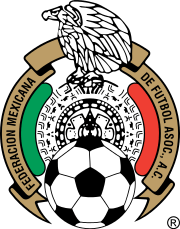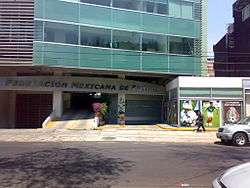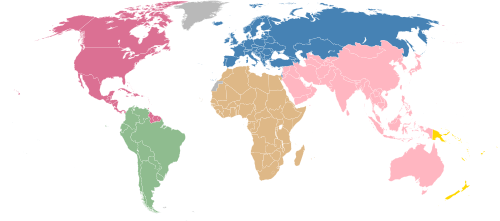Mexican Football Federation
| CONCACAF | |
|---|---|
 | |
| Founded | 23 August 1927 |
| FIFA affiliation | 1929 |
| CONCACAF affiliation | 1961[1] |
| President | Yon de Luisa |
| Website |
www |
The Mexican Football Federation (Femexfut or FMF, Spanish: Federación Mexicana de Fútbol Asociación, A.C.) is the governing body of association football in Mexico. It administers the Mexico national team, the Liga MX and all affiliated amateur sectors, and is in charge of promoting, organizing, directing, spreading, and supervising competitive football in Mexico.
The Federation has three operational centres: the Central Office, the High Performance Centre (Centro de Alto Rendimiento, CAR) and the Training Centre (Centro de Capacitación, CECAP).
FEMEXFUT is a member of the CONCACAF and FIFA, therefore it must comply with the statutes, objectives and ideals of world football's governing body.
The Mexican Federation of Football was established on 23 August 1927 under its first president Humberto Garza Ramos. In 1929 it became affiliated with the FIFA, and later became affiliated with CONCACAF in 1961.
Structure

The Mexican Football Federation's governing body is the General Assembly that conforms with the participation of the Liga MX with 55% of the votes; Ascenso MX with 5%; Liga Premier, with 18%; Tercera División, with 13%, and the Amateur sector, with 9%. Its executive and administrative body is the National Council, which comprises five members, one from each of the divisions mentioned, and are elected every four years.[2]
Competitions
The league is composed of four professional divisions: Liga MX, Ascenso MX, Liga Premier, and Tercera División. The Liga MX Femenil is the top level of women's football in Mexico.
Criticism
Stance on multi-team ownership
The issue of multi-team ownership has been a highly debated one within the owners of the professional football clubs and the Femexfut. Out of Mexico’s 34 clubs in the top two divisions, five ownership groups control almost half the teams, Grupo Pachuca (León, Pachuca, Mineros de Zacatecas, Tlaxcala), Grupo Salinas (Atlas, Monarcas Morelia), Grupo Caliente (Tijuana, Dorados de Sinaloa, Cafetaleros de Tapachula) and Orlegi Deportes (Santos Laguna, Tampico Madero) wield much influence. Most of the owners that have more than one team have them split between the first and second divisions and are in place partly to promote player development.[3]
In May 2013, the owners of the 18 Liga MX clubs voted in favor of a proposal to ban one person or company from owning more than one team. The proposal was introduced after Carlos Slim, whose telecommunications company América Móvil owns a 30% stake in Grupo Pachuca,[4] was rumored to want to acquire Guadalajara (a move he ultimately ruled out). The ruling will not require club owners to sell one of their current Liga MX teams, but will prevent them from acquiring any more.[5]
The issue was once again prevalent in November 2013 when TV Azteca, owner of Monarcas Morelia, paid out 124 shareholders of Club Atlas US$50 million to acquire the club, which for years had been struggling financially.[6]
2026 World Cup Bid
In September 2012, former Mexican Football Federation President Justino Compeán confirmed plans for a Mexican bid.[7] On March 4, 2016, Mexican Football Federation President Decio De Maria announced continued Mexican interest after the new FIFA president Gianni Infantino was elected in the wake of the Garcia Report corruption scandal.[8]In April 2017 The Mexican Football Federation along with Canada Soccer Association and the United States Soccer Federation announced its joint bid to host the World Cup later awarded on June 13, 2018 with 134 votes beating out Morocco's bid by the Royal Moroccan Football Federation with 65 votes. Mexico will host 10 matches along with Canada in 3 cities while United States will host 60 matches in 10 cities including the final. The shortlist of cities will be chosen by June 2020.
See also
References
- ↑ "Ramón Coll, electo Presidente de la Confederación de Futbol de América del Norte, América Central y el Caribe". La Nación (Google News Archive). 23 September 1961.
- ↑ "Introduccion, femexfut" [femexfut introducción] (in Spanish). Femexfut. Retrieved November 10, 2010.
- ↑ Marshal, Tom. "Multi-club ownership causing headaches". Yahoo! Sports. Retrieved 7 February 2014.
- ↑ Harrison, Crayton. "Billionaire Slim Buys 30% Stakes In Mexico Soccer Teams". Bloomberg. Retrieved 31 August 2012.
- ↑ "Mexican club owners move against multi-team ownership". Goal.com. Retrieved 22 May 2013.
- ↑ "Multi-Ownership Is Back; TV Azteca Buys Atlas". soccerly. Retrieved 25 November 2013.
- ↑ "Mexico to bid for 2026 World Cup". ESPN, Press Association. 21 September 2012. Retrieved 9 February 2013.
- ↑ "Mexico wants to host 2026 World Cup as first nation to stage three editions". ESPN, Press Association. 4 March 2016. Retrieved 9 March 2016.
External links
- (in Spanish) Official site
- Mexico at FIFA website
- Mexico at CONCACAF site
Coordinates: 19°25′04″N 99°10′12″W / 19.41779°N 99.169887°W

